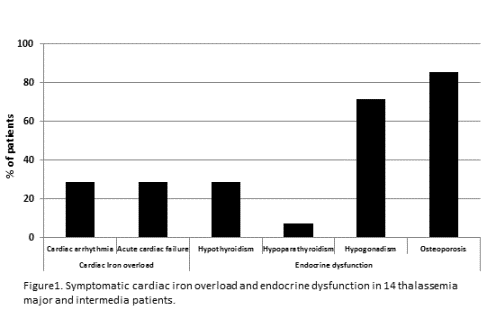
Contributions
Abstract: PB2193
Type: Publication Only
Background
During the past four decades beta thalassemia major (TM) and beta thalassemia intermedia (TI) have transformed from a universally fatal disease at a young age, into a chronic disease, with a constantly increasing life expectancy. This is attributed, amongst others, to the use of improved chelation therapy. Since prolongation of life expectancy has occurred only in recent years, there is little data regarding the older population with TM and TI.
Aims
We aimed to characterize disease and patients’ characteristics in patients above 35 years of age in an adult thalassemia center in Israel.
Methods
We conducted a retrospective analysis of 14 adult patients over the age of 35 years with TM (N=10) and TI (N=4) treated in a single center, specializing in the care of adult thalassemia patients. We used descriptive statistics to describe characteristics of disease and patients and the Mann-Whiteny test to compare between patients with TI and patients with TM.
Results
Between 2006 and 2016, 14 adult patients older than 35 years with TM (n=10) & TI (n=4) were followed and treated in our center. Median patients' age was 37 (range, 35-51) years, with 66% males and 50% of Arab ethnicity. Most of the patients had at least high school education (85%), and 78% were employed.

Conclusion
Advances in the treatment of thalassemia patients have enabled the majority of these patients prolonged survival into adulthood. However, this has brought a new set of challenges for both patients and healthcare. This study delineates the challenges faced while treating adult patients with TI and TM in the new era.
Session topic: 26. Thalassemias
Keyword(s): Treatment, Thalassemia, adult
Abstract: PB2193
Type: Publication Only
Background
During the past four decades beta thalassemia major (TM) and beta thalassemia intermedia (TI) have transformed from a universally fatal disease at a young age, into a chronic disease, with a constantly increasing life expectancy. This is attributed, amongst others, to the use of improved chelation therapy. Since prolongation of life expectancy has occurred only in recent years, there is little data regarding the older population with TM and TI.
Aims
We aimed to characterize disease and patients’ characteristics in patients above 35 years of age in an adult thalassemia center in Israel.
Methods
We conducted a retrospective analysis of 14 adult patients over the age of 35 years with TM (N=10) and TI (N=4) treated in a single center, specializing in the care of adult thalassemia patients. We used descriptive statistics to describe characteristics of disease and patients and the Mann-Whiteny test to compare between patients with TI and patients with TM.
Results
Between 2006 and 2016, 14 adult patients older than 35 years with TM (n=10) & TI (n=4) were followed and treated in our center. Median patients' age was 37 (range, 35-51) years, with 66% males and 50% of Arab ethnicity. Most of the patients had at least high school education (85%), and 78% were employed.

Conclusion
Advances in the treatment of thalassemia patients have enabled the majority of these patients prolonged survival into adulthood. However, this has brought a new set of challenges for both patients and healthcare. This study delineates the challenges faced while treating adult patients with TI and TM in the new era.
Session topic: 26. Thalassemias
Keyword(s): Treatment, Thalassemia, adult


